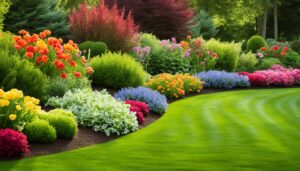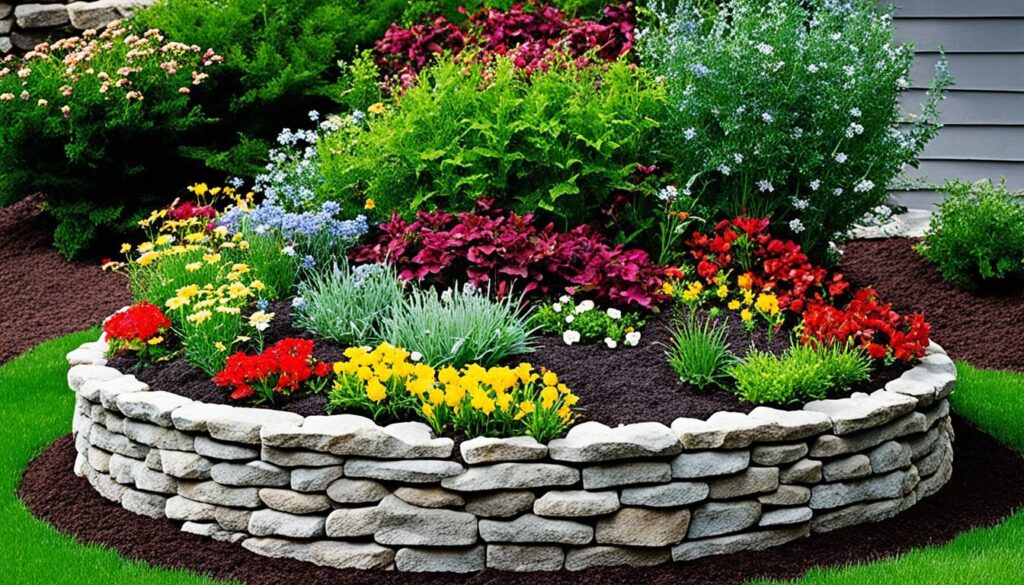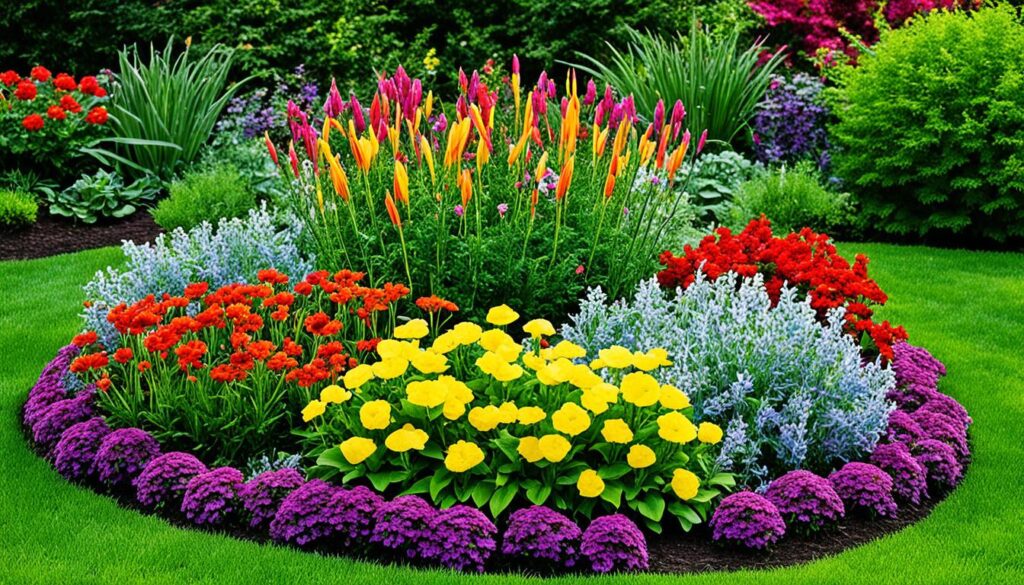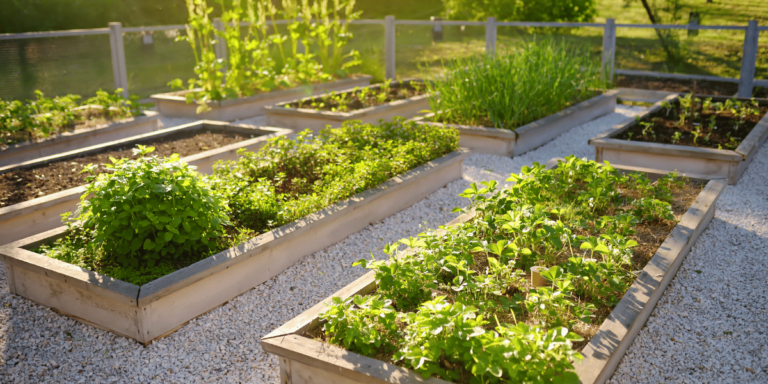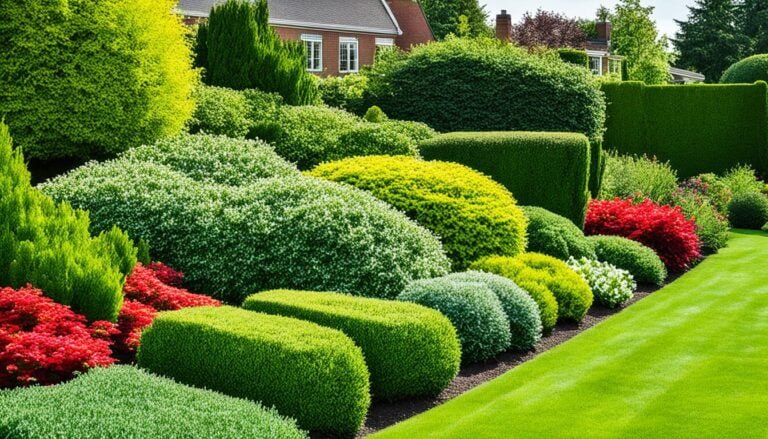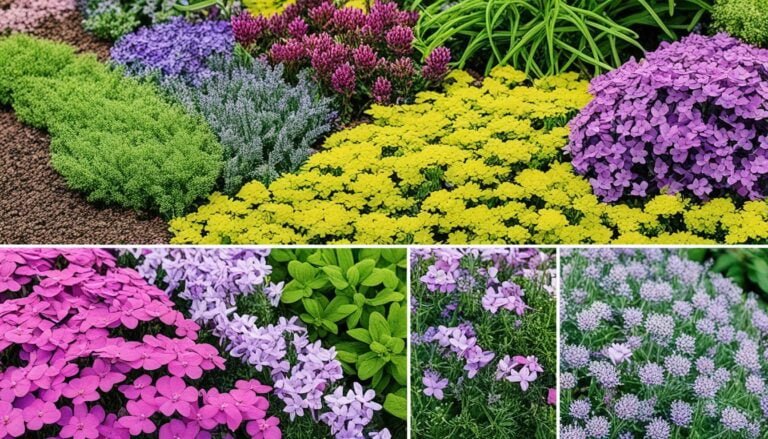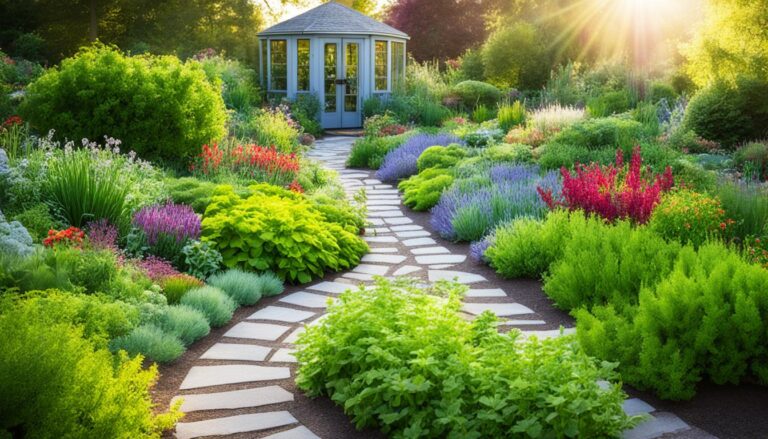Raised Flower Bed Ideas Pictures Turn your backyard into a beautiful spot with smart raised flower bed designs. You can choose from many ideas, like using wood or upcycling materials. These solutions don’t just look good; they also make gardening easier. Wood is versatile, while bricks last a long time. Check out images of raised flower beds to get design inspiration for your garden needs.
Key Takeaways
- Raised Flower Bed Ideas Pictures Wooden raised beds are a popular choice for their strength and economical benefits.
- Bricks provide a durable but costly option for raised beds, requiring some maintenance.
- Rocks add dimension to landscapes but need skillful placement to avoid movement.
- Stock tanks or animal feeding troughs are efficient and cost-effective for raised beds.
- Spiral gardens maximize space, ensuring good drainage and sunlight access.
- Raised beds offer significant benefits such as improved soil drainage and warmer soil temperature.
Benefits of Raised Flower Beds
Raised flower beds are a favorite among gardeners. They help with soil drainage and ease pressure on the back. This improves your gardening experience. Let’s dive into the benefits of using raised flower bed construction.
Improved Soil Drainage
Raised flower beds excel at draining soil. By lifting the garden off the ground, water flows away faster. This stops root rot and soil from getting too packed. It’s key, especially in wet areas. With proper construction tips, these beds keep plants thriving by handling extra water well.
Easier on the Gardener’s Back
Working in raised flower beds is easier for your back. Since the bed is raised, you don’t have to bend over as far. This helps everyone, but especially those with back problems. A detailed DIY raised flower bed tutorial can help you set the right height. Then, gardening is enjoyable for everyone.
Better Control Over Soil Composition
Raised beds let you pick the perfect soil mix. This is different from regular gardens in the ground, where you just get what’s there. By choosing your soil, your plants get exactly what they need to grow healthy. With elevated flower bed plant suggestions, you can match the soil to what your plant likes. This makes your gardening efforts much more successful.
Wooden Raised Flower Bed
Wooden raised flower beds are a great pick for garden lovers. They look beautiful, adding a classic touch to your garden. Plus, they’re cost-effective and handy for gardening.
Durability and Aesthetic Appeal
People pick wooden beds for their garden because they last and look good. Jim Sutton says wood is strong and easy to work with. You can make them in any style, fitting in with any garden design.
Their adaptability means custom designs suit every garden. This makes wooden raised beds great for anyone wanting to do DIY gardening projects.
DIY Construction Tips
Making your own wooden raised bed is fun and simple. Choose treated wood to stop it from rotting. And, if you’re into organic gardening, only use untreated wood to keep chemicals out of the soil.
Here’s how to do it right:
- Select durable wood types like cedar or redwood.
- Ensure proper drainage by drilling holes in the base.
- Use brackets or corner posts to reinforce the structure.
- Line the bed with a landscape fabric to prevent weeds.
By adding various heights and designs, wooden beds make your garden visually appealing. Check out creative raised bed landscaping ideas for inspiration.
Best Plants for Wooden Beds
The best plants for wooden beds are both annuals and perennials. Annuals give your garden color all season like marigolds. Sutton recommends not making beds too tall in cold places to protect these plants.
For real success, plant complementary plants together. A mix of basil and thyme with ornamental grasses look wonderful. This raised flower bed ideas pictures approach can lead to a beautiful garden.
Using Bricks for Raised Flower Beds
Bricks are a standout choice for building raised flower beds. They add a touch of elegance and stand the test of time. These beds inspire garden lovers to craft their dream spaces.
To build a wall over 2 feet high, you’ll need to stack bricks twice. This ensures the bed stays strong. You’ll use several common tools, including a wheelbarrow and a pointing trowel. Don’t forget mortar and bricks themselves.
- Start with a concrete base that’s 12 inches deep. It should be wider than the brick wall and extend below the frost line every 4 feet.
- Build the first few layers to set the base. Each level should be shorter by half a brick than the one below.
- When you need to cut bricks, mark a line around them first. Then, gently hit them with a mallet.
- While laying bricks, clean up extra mortar with a trowel. This helps keep your project tidy.
It takes a bit of practice to lay bricks nicely but the result is solid. In one case, four large beds were finished over six months. They were filled with topsoil and compost mix.
Digging out the ground is hard work and a good workout. Removing rocks and roots creates a smooth base. After planting, you’ll enjoy flowers, herbs, and veggies in your new garden.
| Tool | Purpose |
|---|---|
| Mortar Board | To hold and mix mortar |
| Wheelbarrow | To transport materials |
| Mortar Hoe | For mixing mortar |
| Brick-set Chisel | To cut bricks |
| Mason’s Line | To ensure level rows |
| Pointing Trowel | To apply and shape mortar |
| Joint Raking Tool | To smooth joints |
| Joint Pointer | For fine pointing of bricks |
| Mortar Mix | To bond bricks together |
Looking for lovely raised flower bed ideas? Check out homes in the U.S. These homes feature brick flower beds that blend style with functionality, inviting every passerby to admire them.
Incorporating Rocks for Structure
Adding rocks to your garden’s design brings a natural look. They make your flower beds stand out, especially in flat areas. These features are beautiful all year and are easy to care for. Even if you’re new to gardening, you can make a great design with a few tips.
Benefits of Rock Structures
Rocks in flower beds look great because of their different sizes and shapes. They also make sure your plants can grow well in the local weather. Plus, rocks help stop weeds and keep moisture in the soil. This means you don’t need as much fertilizer.
Building Techniques for Beginners
When making flower beds, use big rocks in light colors to balance the space. Make sure the size of the rocks fits your garden’s look. Watering your plants well is key because rocks can make the soil dry out fast. Adding small rocks or gravel can stop weeds and make maintenance easier. With the right design, these rock features will fit right in with your garden.
Raised Flower Bed Ideas Pictures
Explore our special gallery of raised flower bed ideas. These images show a wide range of styles, perfect for different gardens. You’ll find everything from classic wood to modern metal designs that will spark your creativity.
People love using wood for its durability and budget-friendly benefits. It gives your garden a natural, inviting feel. For a solid option that lasts a long time, consider building with brick. It’s sturdy but can be more expensive. If you’re new to gardening, using rocks is a simple choice, especially for lower beds.
Looking for something different? Try using stock tanks or animal feeding troughs. They are affordable and easy to set up. Spiral raised beds are another smart pick. They raise the center, improving drainage and sunlight for your plants.
| Material | Advantages | Considerations |
|---|---|---|
| Wood | Easy to work with, strong, economical | May require treatment to withstand elements |
| Brick | Long-lasting, strong structure, classic look | Higher cost, requires skilled labor |
| Rocks | Natural look, versatile, beginner-friendly | Heavy, requires more effort to transport |
| Stock Tanks | Cost-effective, easy installation, durable | May require drainage holes |
| Spiral Beds | Maximizes space, excellent drainage, unique design | Complex construction, may need professional help |
When designing your raised bed, consider what’s best for the plants you love. If you enjoy changing your garden every year, go for annual plants in containers. They make care and design changes easy.
If you’re planting perennials, keep your bed under two feet if you have cold winters. This helps protect them from extreme weather.
Pairing plants together wisely can benefit your garden. It can improve soil health and keep pests away. If you find bending hard, opt for tall beds. They’ll make gardening easier and keep animals out.
For a modern look, try using containers or old wood pallets. This will add interesting levels to your garden. Flowering herbs and grasses work well to fill spaces and make your garden feel full of life.
Thinking about the right space between plants is important. It helps avoid battling weeds and lets your plants grow tall and strong. Starting with a small garden bed and growing it over time can make your gardening experience great.
Metal Trough Raised Beds
Metal trough raised beds are a top choice for many. They look modern and are strong. They add a stylish look to gardens. Plus, they have many benefits.
Advantages of Metal Troughs
Metal trough raised beds are very durable. They are made from corrugated metal galvanized sheets. These materials mean they can handle the weather for years. You can find sections in 8′, 10′, and 12′ lengths at stores. This makes them easy to put together and not too costly. The essential materials to build three of these beds are:
| Materials | Quantity | Cost |
|---|---|---|
| Corrugated metal galvanized sheets (8′) | 9 pieces | $157.32 |
| Exterior Screws, 3″ x #10 | 5-pound pack | $30 |
| Self-drilling pan sheet metal screws: #8×3/4″ | – | $9 |
| Redwood lumber: 2×4-16′ | 3 pieces | $57.81 |
| Soil compost mix | 6.75 cubic yards | $350 |
| Tan pavers | 60 pieces | $31.18 |
| Irrigation supplies such as primer, cement, PVC pipes, adapters, and connectors | – | $46.20 |
- Total cost for the project: $681.51
- Cost per bed: $110.40 (soil expenses are excluded)
Drainage Considerations
Good drainage is key for metal trough raised beds. They can hold too much water and cause problems if not managed. Adding drainage holes at the trough’s bottom stops water build-up. This keeps the plants’ roots healthy and the metal from rusting. For even better gardens, consider planting tomatoes, cucumbers, or lettuces in these beds. It’ll make your garden both useful and pretty.
Creative Raised Bed Landscaping Ideas
Enhance your garden with creative raised bed landscaping ideas. These ideas go beyond traditional gardening. You can make a unique statement with your garden. For example, asymmetrical shapes and themed plant collections bring beauty to raised beds.
Using wood for raised beds is popular. Jim Sutton from Longwood Gardens says it looks natural and lasts a long time. But, brick also creates sturdy beds.
Joe Raboine of Oldcastle APG recommends using rocks for attractive raised beds. He also suggests using stock tanks for easy flower bed setups.
Spiral gardens are both beautiful and functional. They help with drainage and look unique. Sutton suggests planting annuals and perennials. They make beds look great. But in cold places, he says keep your beds low to the ground to protect the plants.
Companion planting is great for garden health, according to Sutton. It lets plants help each other grow. For those with mobility issues, raised beds at waist height are a good option. They make gardening easier and keep pests away.
Container gardening is a good choice if you like to change plants often. It also lets you grow a wide variety of plants. Using old wood pallets can add more growing space to your garden.
Herbs and grasses make lovely displays in raised beds. They are perfect for sunny spots and fill empty spaces well. For hills, Sutton suggests terracing the beds. This helps manage water and prevents soil erosion.
For more flexible options, fabric borders are great for renters. Window boxes work well in small spaces. They also make gardening easier for those who can’t bend down easily, notes Raboine.
Spiral Raised Flower Beds
Spiral raised flower beds are a clever way to use gardening space effectively. They also make a beautiful pattern. It’s great for trying out new plant layouts and handling sunlight and water well.
One great thing about these beds is how they create different climates for plants. This means you can grow many types of plants together. For example, you can have annuals and perennials thriving in their own spots.
Making these beds is a fun DIY project. You use materials like rocks which look good in any garden. Using smaller rocks is smart, especially for beginners. This makes building the bed easier without losing strength.
These beds are also good at letting water flow easily. This is key for keeping your plants healthy. By following a DIY guide, you can design a space that is both practical and lovely.
Furthermore, spiral beds look great and work well for planning out your garden. You can mix plants in ways that help them grow better. This could be flowers with herbs or grasses. It creates a good-looking, efficient garden.
If working at ground level is hard, consider making the bed waist-high. This makes gardening easier for people with mobility issues. It’s a nice way to make sure gardening is accessible for all.
In the end, spiral beds are a wonderful idea. They mix beauty with smart use of space, good drainage, and health for your plants. With these designs, your garden can be both useful and a joy to see.
Companion Planting in Raised Beds
Companion planting in raised beds boosts plant health and garden output. It pairs plants that help each other, like keeping pests away or sharing nutrients well. By using creative raised bed landscaping ideas, you make your garden both beautiful and efficient.
Benefits of Companion Planting
Planting this way brings several perks over monoculture. It makes the garden richer and healthier, needing fewer chemicals. This makes it easier to keep diseases and pests at bay, ensuring a strong garden.
- The classic Native American “Three Sisters” combo (corn, squash, and beans) uses space well.
- Flowers with lots of pollen draw pollinators, crucial for plants like zucchinis and fruit trees.
- Herbs like basil, cilantro, and sage naturally keep pests under control by attracting good bugs.
- Marigolds are great at keeping harmful nematodes away, especially in beds with tomatoes, squash, and peppers.
Popular Plant Pairings
Smart plant combos in raised beds mean healthy, vibrant plants. Using creative raised bed landscaping ideas makes your garden both pretty and purposeful.
| Companion Plants | Benefits |
|---|---|
| Beans & Kohlrabi | Mutual benefits in nutrient sharing. |
| Peas & Cabbage | Promotes growth and keeps pests off. |
| Carrots & Peas | They thrive together and suit raised flower beds well. |
| Onions & Cucumbers | Keeps pests away and makes plants healthier. |
| Tomatoes & Basil | Improves the taste of the tomatoes. |
Using raised flower bed decoration ideas and the right plant pairings, you can make your garden inviting and fruitful. It will be beautiful and work well, too.
Raised Bed Design Inspirations
Raised-bed gardening lifts the soil off the ground and contains it in various materials. This approach has lots of benefits. It includes reducing weeds, holding more water, draining well, giving more room to grow, and stopping soil from washing away. You can turn your garden into a gorgeous area with designs that work well and look good.
Using corrugated metal in raised garden beds is both beautiful and different next to wooden frames. Cedar wood is chosen a lot because it doesn’t rot quickly. If you prefer something solid, consider concrete or cinder blocks. If you’re into growing herbs or lettuce, raised beds that look like tables are great. They make gardening easier and more attractive. Tiered garden beds add depth and make the garden more interesting.
For a natural and long-lasting option, use materials like bricks, reclaimed pallets, and landscaping timbers. There are also modern solutions like tables that water themselves or raised beds with covers to keep pests out. Try special ways to plant like using straw bales, creating herb spirals, or making garden beds with trellises. Stock tanks and water troughs work well as planters, too. They are simple and look good in a garden.
Flower beds in raised designs might feature benches and trellises to help climbing plants. In tight spots like balconies, modern cedar planters and wall planters fit perfectly. Mixing different materials and designs lets you design a space that fits your needs and looks the way you want. This makes suggestions for elevated flower beds a key part of your gardening plan.

